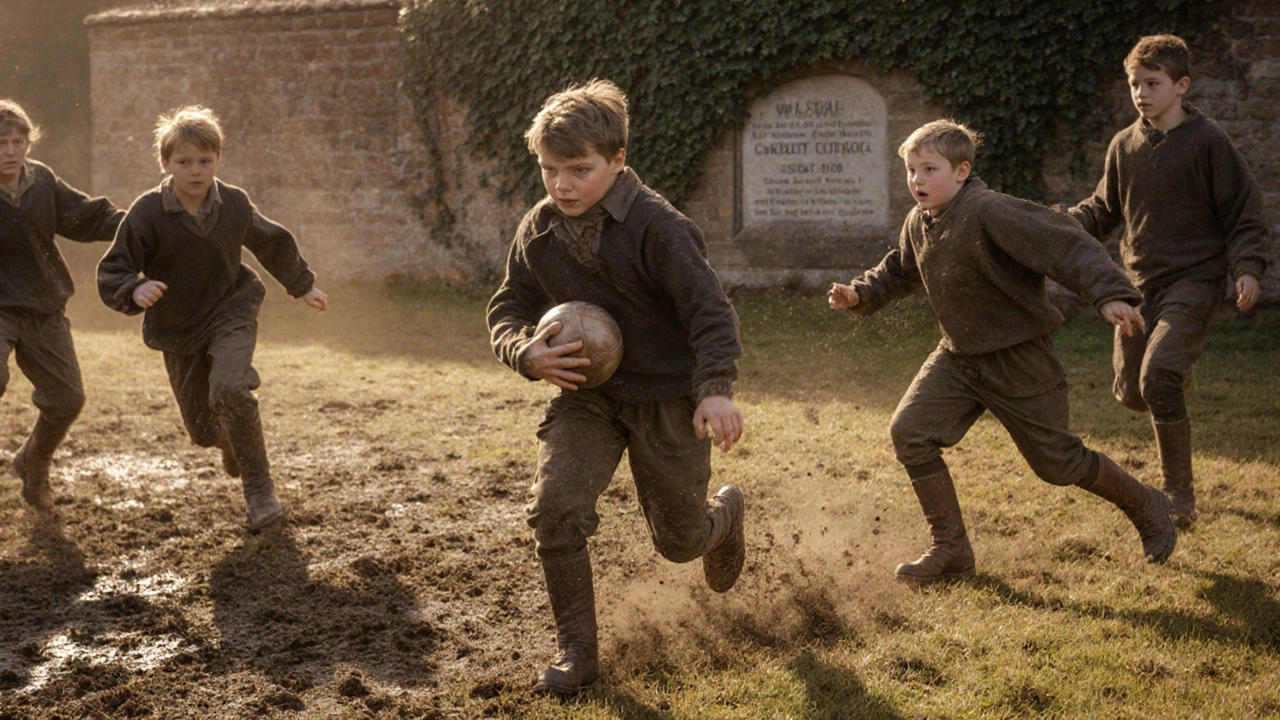Who Invented Rugby? The Real Story Behind the Game

Rugby History Timeline
William Webb Ellis Legend
According to legend, a boy named William Webb Ellis picked up the ball during a football match at Rugby School and ran with it. However, no contemporary records verify this event, and the story first appeared over 50 years later.
Formalizing Rugby Rules
Rugby School developed its own set of rules allowing handling the ball, passing backward, and kicking. These rules spread to other schools as the game became more structured.
First International Match
Scotland and England played the first official international rugby match in Edinburgh. This was rugby union's first international encounter.
Webb Ellis Story Emerges
Matthew Bloxam, a former Rugby School student, first recounted the Webb Ellis story in a letter to the Rugby School magazine, claiming to have heard it from other alumni.
Rugby Split
22 clubs from Yorkshire and Lancashire formed the Northern Rugby Football Union (later Rugby Football League), breaking away from the Rugby Football Union over professionalism. This created rugby league.
All Blacks Tour
New Zealand's All Blacks toured the British Isles, playing 35 matches and winning all of them. Their speed and skill stunned the rugby world and helped establish rugby as a global sport.
Rugby World Cup
The first Rugby World Cup was held in New Zealand and Australia, with the Webb Ellis Cup introduced as the trophy for the tournament champions.
Professionalization
Rugby union officially became professional in August 1995, ending the amateur era. Rugby league had been professional since its formation in 1895.
Modern Rugby
Today's game features professional players, advanced training techniques, concussion protocols, and global television coverage. The core elements of rugby remain unchanged, but the game has evolved significantly in terms of safety, strategy, and professionalism.
Everyone knows rugby is a rough, fast-paced game played with an oval ball, but few know how it actually started. The story most people hear goes like this: in 1823, a boy named William Webb Ellis picked up the ball during a football match at Rugby School in England and ran with it. That act, they say, invented rugby. But is that true? And if it is, what really happened back then?
The Legend of William Webb Ellis
The tale of William Webb Ellis is engraved into rugby’s identity. A plaque at Rugby School in Warwickshire says: "This stone commemorates the exploit of William Webb Ellis who with a fine disregard for the rules of football as played in his time first took the ball in his arms and ran with it, thus originating the distinctive feature of the rugby game." It was placed there in 1895, over 70 years after the alleged event.
But here’s the problem: no one wrote about it at the time. No school records, no newspaper reports, no letters from students mention Webb Ellis breaking the rules in 1823. The story didn’t surface until 1876 - more than 50 years later - when a former student named Matthew Bloxam recalled hearing it from another alumnus. That’s not evidence. That’s a memory passed down like a campfire story.
Still, the Rugby Football Union embraced the myth in 1895 to give the sport a clear origin point. It helped unify the game as it split from association football (soccer). So while Webb Ellis may not have actually done it, he became the symbolic father of rugby.
How Rugby Actually Evolved
Football in the 1800s wasn’t one game - it was dozens. Every school, town, and university had its own version. At Eton, players couldn’t touch the ball with their hands. At Harrow, they could. At Rugby School, the rules were looser. Kids played a version where running with the ball was allowed, but it wasn’t a sudden breakthrough by one boy. It was a slow shift in how the game was played.
By the 1830s and 1840s, Rugby School had formalized its own set of rules. They allowed handling the ball, passing backward, and kicking. They even had goalposts and scoring systems. Other schools began copying them. The game spread because it was fun, physical, and different from the stricter football games elsewhere.
There’s no single inventor. Rugby was invented by a group of boys playing in muddy fields, tweaking rules as they went. It was a grassroots evolution - not a eureka moment.
The Split That Made Rugby Its Own Game
By the 1870s, rugby had grown beyond schools. Clubs formed in London, Yorkshire, and beyond. But tension grew between those who wanted to keep the game amateur and those who wanted to pay players - especially working-class men in the north of England.
In 1895, 22 clubs from Yorkshire and Lancashire broke away from the Rugby Football Union. They formed the Northern Rugby Football Union, which later became the Rugby Football League. This split gave birth to rugby league - a faster, more professional version of the game with 13 players per side and different rules.
The original game kept its name: rugby union. It stayed amateur until 1995, when the International Rugby Board officially declared the sport open to professionalism.
So today, there are two main codes: rugby union and rugby league. They share roots but have different rules, cultures, and even global followings. Rugby union dominates in New Zealand, South Africa, and Wales. Rugby league thrives in Australia, northern England, and Papua New Guinea.

Why the Myth Still Matters
Even though the Webb Ellis story is likely exaggerated, it’s not just a fairy tale. It gave rugby a founding moment - something every sport needs to build identity. The Webb Ellis Cup, awarded to the Rugby World Cup winners since 1987, keeps the myth alive. Every time a player lifts that trophy, they’re touching a piece of legend.
And in a way, the story works. It captures the spirit of the game: bold, unconventional, willing to break the rules for something better. That’s why it stuck.
What Rugby Looked Like in the 1800s
Early rugby wasn’t like today’s televised spectacle. Games were played on open fields with no standardized pitch size. Teams could have 20, 30, or even 50 players. There were no numbered jerseys, no substitutions, and no time limits - matches lasted until someone scored twice.
Players wore heavy woolen shirts, leather boots with no ankle support, and sometimes no padding at all. Tackling was legal, but there were no rules about high tackles or dangerous play. Injuries were common. The game was brutal - and that’s part of why it became so popular.
Ball shape was irregular. Early balls were made from pig bladders, inflated by mouth. They weren’t perfectly oval - sometimes they were round, sometimes lumpy. It wasn’t until the 1870s that manufacturers started making consistent oval balls to make passing easier.

How Rugby Spread Around the World
British soldiers, sailors, and teachers carried rugby to colonies and former colonies. It took root in places where British influence was strong: Australia, New Zealand, South Africa, Fiji, Japan, and Argentina.
By the 1880s, international matches were being played. The first official test match was between Scotland and England in 1871. New Zealand’s All Blacks toured the British Isles in 1905 and stunned everyone with their speed and skill. That tour turned rugby into a global phenomenon.
Today, over 120 countries play rugby union. The Rugby World Cup, held every four years, draws millions of viewers. The 2023 tournament in France saw over 1.2 million tickets sold and billions of television viewers.
Modern Rugby vs. the Original Game
Compare a 1840s match to a 2025 Six Nations game and you’re looking at two different sports.
Then: no helmets, no mouthguards, no video replays, no coaches on the sideline. Players were amateurs who played for love of the game. Matches could last hours.
Now: strict rules on tackling, concussion protocols, performance analytics, professional contracts, and TV broadcasts in 4K. Players train like athletes - strength coaches, nutritionists, sleep specialists. The game is faster, smarter, and more physical than ever.
But the core hasn’t changed. You still pick up the ball and run. You still tackle hard. You still pass backward. You still fight for territory and try to ground the ball over the line. That’s the heartbeat of rugby - and it’s been there since the first boys at Rugby School decided to break the rules.
Where to Learn More
If you want to dive deeper, the Rugby Football Union archives in Twickenham hold original rulebooks from the 1840s. The World Rugby Museum, also at Twickenham, displays the first rugby ball ever used in an official match - a hand-stitched pig bladder from the 1850s.
Books like The Birth of Rugby by John Griffiths and Rugby: The People’s Game by David Parry-Jones give detailed accounts of how the sport evolved from schoolyard chaos to global spectacle.
And if you’re ever in Rugby, England, visit the school. Walk the same grounds where the game began. Look at the plaque. Then ask yourself: did one boy change history? Or did history just need a story to hold onto?
Did William Webb Ellis really invent rugby?
There’s no solid proof that William Webb Ellis picked up the ball in 1823. The story was first told over 50 years later and likely grew over time. But he became the symbolic founder of rugby because the sport needed a clear origin story. The real invention was a slow evolution of rules at Rugby School, not a single moment.
What’s the difference between rugby union and rugby league?
Rugby union has 15 players per side, contested scrums, and lineouts. Rugby league has 13 players, fewer stoppages, and a play-the-ball after a tackle. League is faster and more focused on continuous play. Union is more strategic and physical. They split in 1895 over payments to players.
When did rugby become professional?
Rugby union turned professional in August 1995, after the International Rugby Board declared the sport open. Before that, players were officially amateurs, even though many received under-the-table payments. Rugby league had been professional since its formation in 1895.
Why is the rugby ball oval?
Early rugby balls were made from pig bladders, which were naturally irregular and oval-shaped. As manufacturing improved, manufacturers kept the oval design because it was easier to carry and pass. By the 1870s, the shape was standardized to improve handling and kicking.
Which countries play rugby the most?
Rugby union is most popular in New Zealand, South Africa, England, Wales, France, and Australia. Rugby league dominates in Australia, Papua New Guinea, and northern England. Countries like Fiji, Tonga, and Samoa have some of the strongest national teams relative to their population size.
